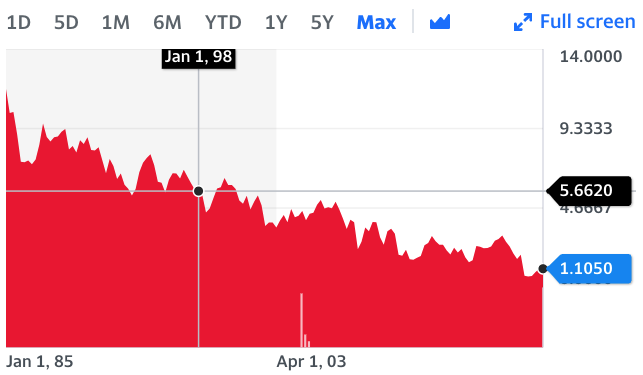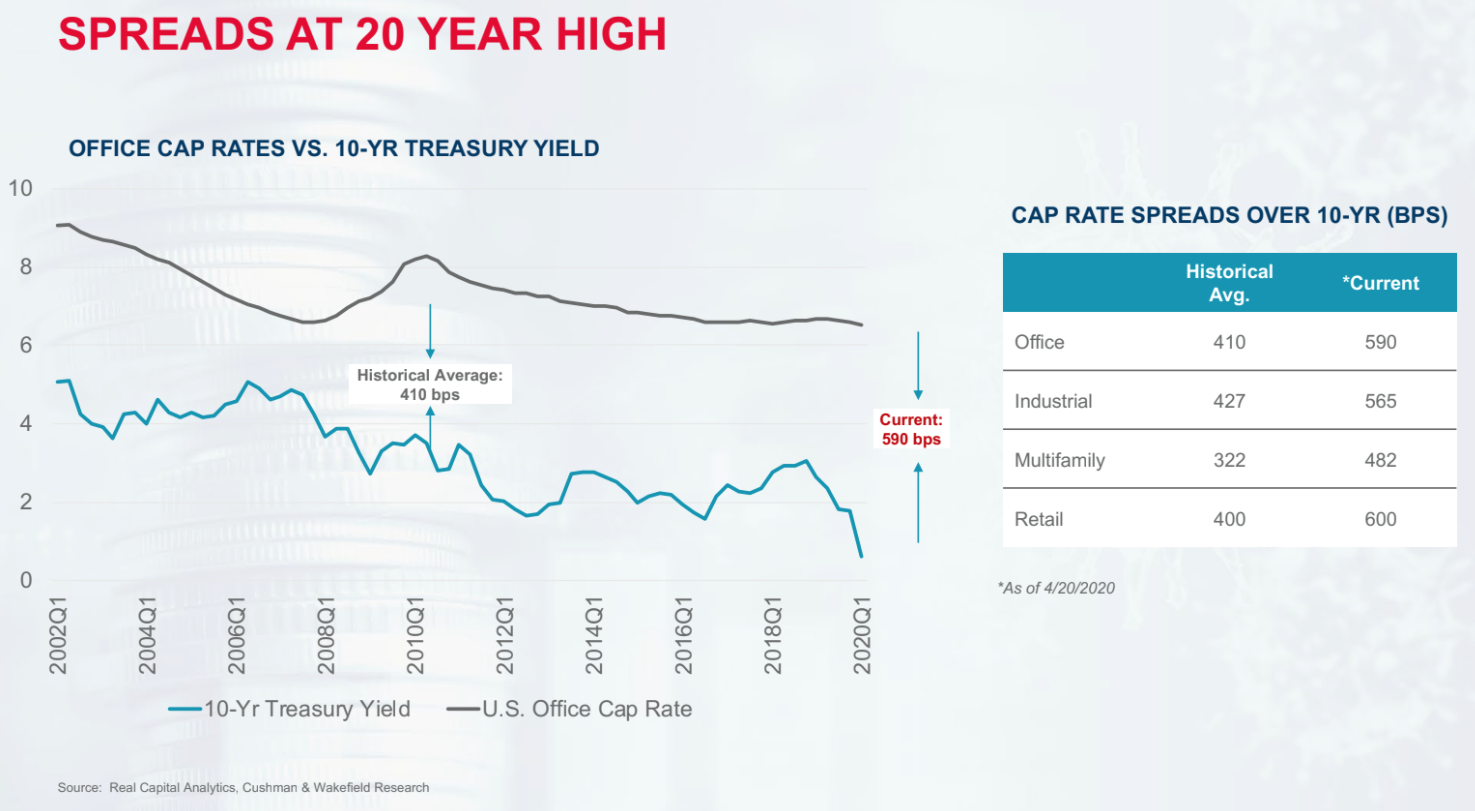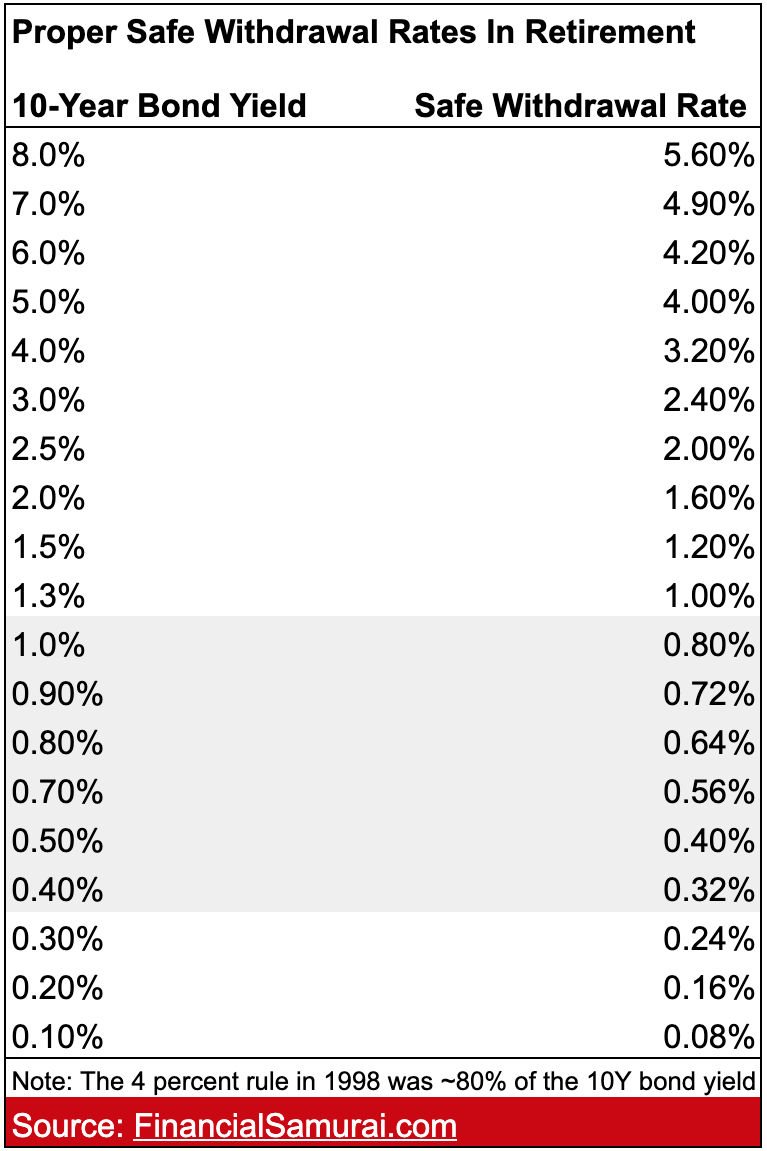For Untemplaters out there who want to make their money last for generations, there is a new safe withdrawal rate to follow in retirement. It’s called the Financial Samurai Safe Withdrawal Rate. The safe withdrawal rate formula is the 10-year bond yield X 80%.
On Thursday, August 27, 2020, the Federal Reserve announced a major policy shift. Fed Chair Jerome Powell said the Fed is willing to allow inflation to run hotter than normal in order to support the labor market and broader economy.
In other words, the Federal Reserve is likely to keep its Fed Funds rate at or near zero percent for longer. In the past, the Federal Reserve would consider raising interest rates when the unemployment rate falls to ward off inflation down the road.
Given this policy shift, it would be wise to lower your safe withdrawal rate in retirement. It takes a lot more capital to generate the same amount of risk-adjusted returns. Further, when interest rates stay low for longer, asset bubble may form and pop.
Why The 4 Percent Rule Is Dead
The “4% Rule” was first published in the Journal Of Financial Planning in 1994 by William P Bengen. It was subsequently made popular by three Trinity University professors in 1998 called the Trinity Study. At the time, inflation and interest rates were much higher and pensions were common.
In 1998, when the Trinity Study made the 4% Rule popular, the 10-year bond yield was between 4.41% to 5.6%. The average 10-year bond yield rate was 5% in 1998.
Therefore, of course you’d likely never run out of money in retirement following a 4% withdrawal rate. You could earn 5% on average risk-free! This is where I come up with the 80% in the formula. 4% is 80% of 5% back when the 4% Rule was created. Therefore, I’m simply being consistent with Bill Bengen and the Trinity Study.

Today, the 10-year bond yield is at around 1.1%. It got to a low of 0.51% in August 2020.
Given the dramatic decline in the 10-year bond yield since the 4% Rule was popularized, it doesn’t make sense to stick to a rule from over 22 years ago.
The 10-Year Yield’s Importance
Returns in the stock market, bond market, and real estate market are all relative to the risk-free rate of return (10-year bond yield). If the risk-free rate of return declines, so do overall returns for risk assets ceteris paribus.
Let me share some examples on the 10-year yield’s importance. The 10-year bond yield is intertwined in all risk asset class returns. These asset classes include stocks, real estate, private equity, venture capital, venture debt, and more. After all, the 10-year bond yield is the opportunity cost of investing in another asset.
Example #1: A Decline in Corporate Bond Yields
A company looking to raise money to fund operations isn’t going to issue a bond that pays 8%, unless it’s in dire straits. Instead, a company will probably discover that adding a 2% – 3% interest rate premium to the 10-year bond yield will garner enough demand.
In other words, companies can raise debt at a cheaper price when the 10-year goes down. In turn, the company can use the debt to fund operations or acquire new companies. With more expansion and acquisitions, company profits may go up.
Example #2: A Decline In Stock Dividend Yields
Let’s say you prefer investing in dividend stocks over growth stocks. As a result, you care about a dividend stock’s dividend yield and payout ratio.
A company you are considering has historically paid a 60% dividend payout ratio. During the ups and downs, the company’s dividend yield has range between 3% – 4%. The company has always wanted its shareholders to earn at least a 1% premium to the 10-year bond yield.
With the 10-year bond yield down to ~1.1%, the company can now cut its dividend payout ratio and provide closer to a 2.1% – 3.1% yield. The company can then keep more retained earnings for growth and operations.
Example #3: Increased Interest In Real Estate
Let’s say you want to take advantage of potential distressed asset opportunities in commercial real estate. One of the key ways to find opportunity is to monitor the spread between cap rates versus the 10-year treasury yield. The greater the gap, the greater the potential profit potential.
With the pandemic, the current office cap rate vs. 10-year treasury yield spread is at its highest in history. Therefore, commercial real estate might generate some greater returns in the future. The asset class has certainly lagged stocks and residential real estate.

When it comes to investing, everything is intertwined. The 10-year bond yield has direct implications for asset returns and yields. Let me demonstrate.
Few Follow A 4% Safe Withdrawal Rate
What’s funny about the 4% Rule is that its proponents don’t even follow the rule! Most follow the new safe withdrawal rate I have proposed.
For example, William P Bengen, the creator of the 4% rule mentioned in my post on the proper safe withdrawal rate that he’s onto his 4th career as an author and researcher. You can read his comment on my site for yourself. He is happily making money, therefore, he can afford to have a withdrawal rate of 0%.
Meanwhile, other retirement experts and financial advisors are certainly not following a 4% safe withdrawal rate because they are all still working.
Finally, since leaving my day job in 2012, I have yet to meet a single FIRE blogger who regularly withdraws 4% from their portfolio to pay for living expenses. Instead, FIRE bloggers are almost always earning supplemental retirement income online.
I am no exception. But I haven’t told anybody I’ve been retired since a year after I left finance in 2012. After a year of traveling and twiddling my thumbs, I focused on writing on Financial Samurai. It felt disingenuous to say I was retired when writing these posts takes hours to write!
Finally, I have yet to meet an early retiree in person who withdraws at a 4% or higher rate. Every single person I know earns some type of supplemental retirement income that brings them joy and purpose. Therefore, the vast majority of people follow the new safe withdrawal rate and probably don’t even know it.
The New Safe Withdrawal Rate To Follow
If you have children or plan to donate to charities after you are gone, it’s important to plan financially beyond yourself.
Given the 4% Rule was established at a 20% discount to where the 10-year bond yield was at the time, we can also establish a similar 20% discount to today’s 10-year bond yield to come up with a new safe withdrawal rate.
With the 10-year bond yield at ~1.1%, a safe withdrawal rate is actually closer to 0.88%. When the 10-year bond yield was at its low of 0.51%, the safe withdrawal rate was equivalent to 0.4%.
To make things simple, the new safe withdrawal rate equals the 10-year bond yield X 80%. Let’s call this the Financial Samurai Safe Withdrawal Rate.
For reference, below is a table I created using the Financial Safe Withdrawal Rate formula.

Three Ways To Use The Financial Samurai Safe Withdrawal Rate Rule
1) Stretch Net Worth Growth Target
With the 4% Rule, you multiply your annual expenses by 25 to get a target net worth. If the new safe withdrawal rate is 1%, you multiply your annual expenses by 100 to get a target net worth.
For example, if you want to live off $50,000 a year in retirement and have no other income streams, then your stretch net worth target is $5 million based on the new safe withdrawal rate rule.
For a more reasonable net worth target, may I suggest the 20X Gross Annual Income Rule. With this rule you can’t cheat by simply lowering your annual expense budget. The 20X gross income rule forces you to accumulate more wealth as your income grows. It also makes you better decide whether you want to continue your way of life.
2) Calculate How More More Wealth Is Left To Build
A less onerous way to calculate your retirement net worth goal is to add up how much retirement income you already have and subtract it from your desired retirement income.
For example, let’s say your passive income portfolio already generate $30,000 a year, but you desire to earn $50,000 a year. The difference is $20,000. Therefore, if the new safe withdrawal rate is 1%, your goal is to try and amass another $2 million in net worth, regardless of what your existing net worth is.
This is where the new safe withdrawal rate really excels.
3) Reverse engineer your desired safe withdrawal rate.
Use the Financial Samurai Safe Withdrawal Rate only as a net worth target. Once you’ve reached your net worth target based on the FS Safe Withdrawal Rate, then you can change your safe withdrawal rate as you see fit.
For example, let’s say you are happy living off $50,000 a year in retirement. You don’t have a pension, Social Security, or any passive income. A safe withdrawal rate of 1% dictates that you will need to amass a $5 million net worth. Let’s say you succeed in getting to $5 million by age 70 and expect to live until age 90.
With an expected 20 years left to live, you could divide your $5 million by 20 and safely withdraw $250,000 a year. Withdrawing $250,000 a year is equivalent to a 5 percent withdrawal rate. If there is a bear market or big unexpected expense during this time, you can adjust your withdrawal rate accordingly.
The Way Around The Financial Samurai Safe Withdrawal Rate Rule
Obviously, when the 10-year bond yield is low, following the Financial Samurai Safe Withdrawal Rate will be more difficult. Therefore, the easiest way to circumvent my new safe withdrawal rate is to earn supplemental income.
For example, let’s say you want to live off $50,000 a year in retirement income. This would equate to having a $5 million net worth using a 1 percent safe withdrawal rate. Unfortunately, you’ve been blindly following the 4 percent safe withdrawal rule. Therefore, you thought accumulating $1.25 million was enough.
You now realize the 4% Rule was developed in 1998 when the 10-year bond yield averaged 5%. After cursing out the Federal Reserve for slashing rates to zero, you calm down and figure out the gap.
Your $1.25 million can only safely generate $12,500 a year in passive income at 1%. Therefore, your retirement income shortfall is $37,500 ($50,000 desired retirement income – $12,500 your true retirement income). You are also too young to collect Social Security, nor do you have a pension.
Since you don’t think you’ll ever get to a $5 million net worth, you need to find a way to make $37,000 a year in supplemental retirement income. Thankfully, there are multiple ways to make money from home nowadays if you start a website like this one. You can also freelance.
Taking More Risk By Reaching For Yield
The final way to circumvent the new safe withdrawal rate is to take more risk. To be able to sustain a higher withdrawal rate, the retirement portfolio must either generate higher yields, higher returns, or both.
Ideally, if you don’t make supplemental retirement income, you want to have a portfolio that yields your desired withdrawal rate or higher. Instead of investing a more conservative 50/50 equity/bond portfolio, perhaps you’re comfortable shifting the equities allocation up to 70%.
A retiree does not have to only invest in bonds or risk-free assets in retirement, despite my new safe withdrawal rate rule.
Here are some investment ideas that have the potential to generate higher yields.
- A REIT ETF like VNQ, which has a yield of ~2.5%
- Individual REITs like O, which has a yield of ~4%
- Private eREITs, where I’ve been recently investing my money
- Investing in individual dividend-paying stocks like AT&T with a forward yield of ~6.5%
- Investing in a dividend ETF like VYM with a ~3% yield
- Buying rental property
- Lending out hard money (not a big fan)
- Buying an annuity (not a fan)
However, the more risk you take, the greater the chance of losing money Therefore, it’s important to assess your own risk tolerance and invest accordingly. The new safe withdrawal rate is very conservative to ensure you never run out of money.
Retirement Life Will Be Different Than What You Imagine
As someone who left his day job in 2012 at 34, I’m providing you some firsthand retirement perspective. It is easy to pontificate about the proper safe withdrawal rate in retirement while you still have a steady paycheck.
But I assure you, only when you and your partner no longer have a steady paycheck will you genuinely experience all the emotions that comes with being unemployed. And let me tell you, not all of the emotions are positive.
You may find it extremely uncomfortable to go from building your investment portfolio all your life to withdrawing. I know I did. Until this day, I still have not touched a dollar of principal from my retirement savings.
Use The New Safe Withdrawal Rate Rule As A Guide
Don’t be mad at the Financial Samurai Safe Withdrawal Rate. If anything, be mad at the Federal Reserve and the government for saving us from a global pandemic. The trillions in stimulus have crushed interest rates. Further, the debt will eventually have to be paid back.
Thankfully, none of us are zombies. We don’t aimlessly follow a safe withdrawal rate rule until we die. Instead, we adjust based on economic conditions. Further, there should be Social Security income, perhaps just not the full amount as promised.
My new safe withdrawal rate rule of the 10-year bond yield X 80% is just a net worth and safe withdrawal rate guide in this low-interest rate environment. Nobody is forcing you to follow it.
Depending on how much of your wealth you want to pass on and how much risk you want to take, my safe withdrawal rate rule may be too aggressive or too conservative. Only you can decide.
At the very least, let us agree that following a 4% safe withdrawal rate today is misguided. We must adjust our retirement planning based on the realities of the world today.
My new safe withdrawal rate is meant to encourage all retirees to generate supplemental retirement income through an activity that brings them joy and provides them purpose. Using my new safe withdrawal rate formula to calculate a target net worth is of secondary consideration.
Personally, I plan to keep on trying to generate as much active and passive income as possible. Once we reach herd immunity, fingers crossed, then it’ll finally be time to take things down a notch and live the untemplate lifestyle once more. Here’s hoping that our investments cooperate in the meantime!
Readers, what do you think is an appropriate safe withdrawal rate in this low-interest rate environment? After such a long bull market, have investors become complacent in always expecting positive returns? Why do think people still believe in the 4% Rule when the risk-free rate of return was 5% when the rule was first created?
Thanks for the great post! As I calculate and recalculate my FI number this new perspective is extremely valuable!
It’s kinda crazy how much rates have come down. I used to love having CDs accounts and high yield savings accounts but not anymore. I think I earned a whopping 10 cents in interest last year or something pathetic like that.
Makes sense to make adjustments to how much to save for retirement and how much to withdraw with significant changes like this. I don’t see rates going up significantly for a long time either. Thanks for the recommendations!